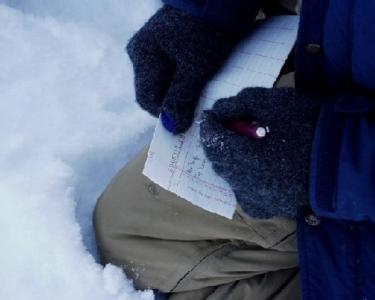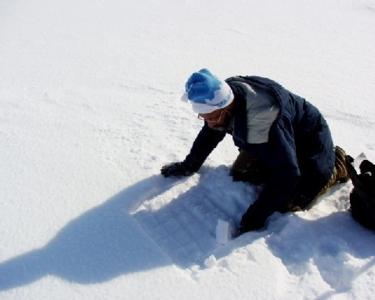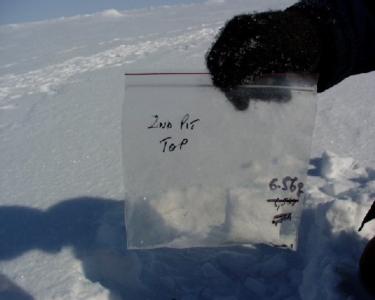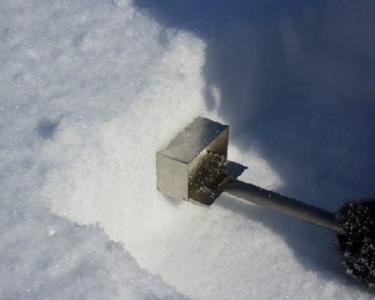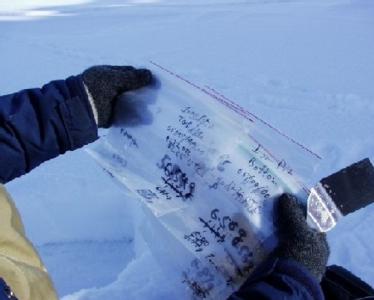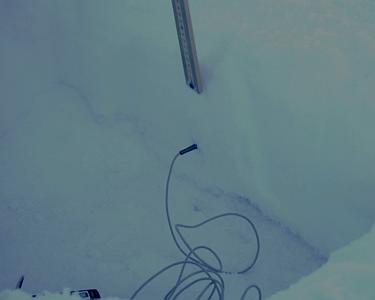
|
10 May, 2000Testing Snow Density DRAFT May 10, 2000 Daily Data (20:30): Lat. 6822.6221N Long. 06104.701432W Heading 44.352 Air Temp. -11.00C 12.20F True Wind Dir. 330 True Wind Speed 30 knots USCGC Healy Facts: Three Conning Stations: Pilothouse, Aloft Conn, and Science Conn providing automated control and navigation Vans: space for eight with services Inuit Language Lesson from Stevie Audlakiak and James Qillaq: Atetua (ah teck’ tah): Bear cub Nateauk (nlek’ tia): Seal pup Dear Everyone, Today was the first day that I was cold on the ice floe. In spite of the brilliant sunshine, I experienced the reality of the wind-chill factor. Luckily the wind was to our backs as the ice thickness profiling teams began measuring ice thicknesses along the Healy's track of broken ice. We collected data for a distance of 2,060 meters today. Due to the cold conditions and distances to be covered, the snow machine (Ski-Doo) was strapped and hoisted by crane over the side of the Healy and onto the floe. It was not only used to transport the ice drilling equipment, but also to shuttle us back to the ship. Chris Meadus (the Newfie’ as he calls himself), Institute for Marine Dynamics, St. John's, Newfoundland, Canada, bounced off the snow machine, threw me into the snow and then plopped me into the driver's seat. "You’re driving," he shouts through my cap's earflaps and pulled up neck gaiter as he jumps on behind me. "Ever drive a Ski Doo?" As I shake my head "No," he orders, "Squeeze this lever." Off we went as Bill and Stevie scrambled onto the sled we were pulling. It didn't take but one ridge for me to learn that flying over them was the fun part. Although I assisted the ice profiling teams today, yesterday one of my activities was helping Devinder Sodhi, U.S. Army Cold Regions Research and Engineering Laboratory (CRREL), Hanover, NH, collect samples for his snow density tests. Why is snow density important to the Healy Ice Trials? Snow offers resistance to ships during their forward motion. To account for the snow on ice, some researchers calculate equivalent ice thickness as the sum of ice thickness and half or one-third of snow depth. A better estimate of the effects of snow on ship motion can be obtained from the measured snow depths combined with the density of the snow. Dev Sodhi carefully carved out and measured a rectangular area of snow using a small metal spatula (pancake turner). It's exactly like one I have in my kitchen at home. I learned that the tools used in field research do not necessary need to be high-tech or expensive. They simply must do the job. Using a probe and meter, Dev Sodhi took the temperature of various levels of snow while I recorded this information on his data sheet. We found that on the shaded portside of the Healy, the heat was going through the snow from the ice sheet to the atmosphere. The snow was colder. At the bow of ship where it was sunny, the heat was coming from the sun through the snow to the ice sheet. The snow was warmer. Once the temperatures were taken, Dev Sodhi captured a sample of snow using a specially designed device for collecting exactly 100 cc (cubic centimeters). This snow was then placed into pre-weighed quart sized zip-lock plastic bags. The mass of each bag was weighed and labeled with permanent black marker. Snow samples were collected from two small sections (called ‘pits’) in close proximity to the ship. I helped Dr. Sodhi make his collections from the portside and the bow of the Healy while it was parked in the ice floe. Back on board the Healy, the mass of each zip-lock bag of snow was weighed. The mass of the snow sample was obtained in grams by subtracting the mass of each bag from its total mass (the snow plus the bag). We already know that the volume of the snow was 100 cc. Vocabulary of the day from Dr. Devinder Sodhi: Density: This is the amount of matter in a sample or a body in terms of mass divided by its volume. For example, pure water has a density of 1.0 Mg/m^3: 1000 kg/m^3 = 1 Mg/m^3 = 1 Mg m^-3 Ice has a density of about 0.91 Mg/m^3. Because snow has a lot of air in it, its density is very low and varies according to its compression (how packed it is). Snow density can vary from 0.1 to 0.6 Mg/m^3. Mass: The amount of matter in a body. It is measured in kilograms (kg). Weight: The weight of a mass is the gravitational attraction between the mass and the earth. Because the gravitational acceleration is almost constant on the surface of the earth (not exactly 100%), we obtain the mass of the substance when it is weighed. If the same matter was weighed on the moon, the weight would be one sixth of the weight on earth even though the mass would be the same. Snow density = mass/volume Following you will find the snow density measurements taken for May 9, 2000 at 1200 UTC. Best regards, Sandra Date: 09-May-00 Time: 1200 UTC SNOW DENSITY MEASUREMENTS Total mass, bag mass and snow mass are in grams (g). Pit #1 Top	48.87	6.54	42.33	423.3 Middle	38.05	5.84	32.21	322.1 Bottom	26.92	06.5	20.42	204.2 Snow depth = 29 cm
Air temperature -9.0 C (in shadow) For photos and more: ../tea_kolbfrontpage.html For further information: ../ http://www.uscg.mil./pacarea/healy
Contact the TEA in the field at . If you cannot connect through your browser, copy the TEA's e-mail address in the "To:" line of your favorite e-mail package. |
||||||||||||||||||||||||||||||||||||||||||||||||||||||||||||||||||||||||||||||||||||||||||||||||||||||||||||||||||||||||||||||||||||||||||||||||||||||||




